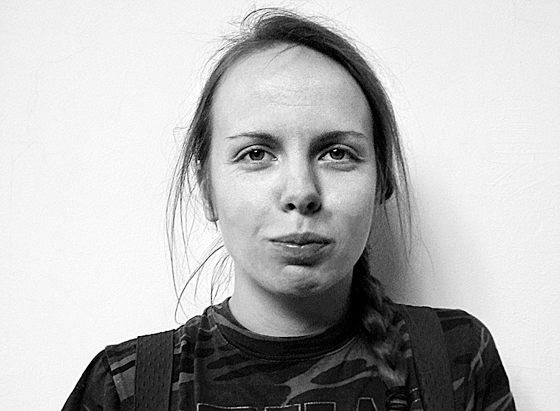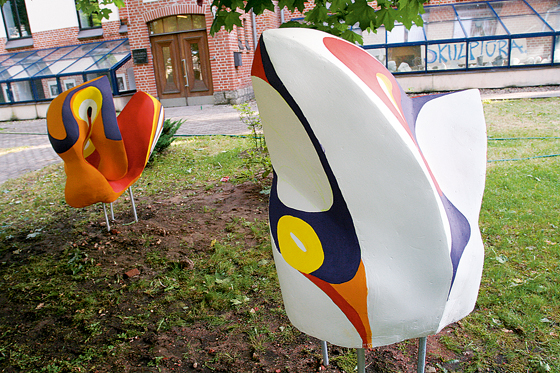|
|
| Gundega Evelone Santa Mičule, Art Academy of Latvia | |
 Gundega Evelone. 2012 Photo from the private archive of Gundega Evelone | |
| Certain signs lead me to think that works of art that to some extent can be considered as sculpture have experienced a boom in the last few years, and not only in terms of the number of exhibitions or prestigious nominations. It can also be detect ed in a loosening of forms and the integration of visual codes characteristic of other art media, that enrich the language of sculpture and extend its functionality beyond that of grappling with solitary inherent artistic problems. The fact that sculpture is in fashion (by “fashion” meaning not the blind following of some other people’s taste, but holding one’s hand and trowel on the pulse of the current mood of the time), is also attested by the works and artistic activities of Gundega Evelone (born 1988). At the moment Gundega is continuing her sculpture stud ies as part of a master’s course at the Art Academy of Latvia. She also draws, paints, organises performances and participates in them; she wraps classics of Latvian poetry and other heroes of memorial monuments prominent in the urban environment in black plastic, and she makes plaster casts of girls’ cleavages at openairfestivals.Gundegaisalsoacuratorof artexhibitions,she helps children learning modelling at art schools, participates in international art symposiums, constructs watering devices for street birds, in short – she does a lot, frequently and visibly. | |


| |
| The activities listed above can be perceived as a kind of ex tension of Gundega’s art objects, because in those, too, a positive condition of unrest is evident to a great degree. This is implicitly articulated by both the vibrations of movement and rhythm in the structure of the works, as well as by the artist’s ability to in ject irony in the interpretation of any subject. Thus not always it is possible to draw a strict border between art activities and the things that cannot be considered art, because a creative approach is Gundega’s lifestyle, outside the sculpture studio as well. An illustrative example comes to mind: her idea to dig a passage in the snowdrift, several metres high, of snow shovelled from the roof of the Art Academy. This was later given the title Tract. In the mass of snow Gundega saw excellent material for the creation of a new spatial structure. Right up to the melting of the snow, academy students used it as an unusual labyrinth shaped smoking room. Sculpture as a space or form that em braces the viewer was also created, together with colleagues, as part of the scenography at the 75th Carnival of the Art Academy, in the big hall – the so called “Harlem stomach” – emphasizing the principle of impact of form, so vital for Gundega, to which the logic of an artwork is subordinate. The diversity of Gundega’s artworks in terms of the cho sen material, subject and style bears witness to a search for and formation of a creative handwriting. This quest, in my opinion, most often has been expressed in two mutually contradictory principles. The first of these could be termed, to limited extent, as following the traditions of realism, and it is more characteristic of the works done as part of her academic studies. The second principle, on the other hand, is characterised by an articulation of artistic images and ideas that tends towards abstract stylisa tion of form. The works corresponding to the first principle are linked to the artist’s interest in documenting the forms of the outer world with socalled realistically impressionistic treatment, merging the visually recognisable with formally autonomous details – the colouring, the painterly roughedup surface, etc. An example of such a tendency is Gundega’s bachelor’s work Laikabiedri (‘Contemporaries’), where the sculptress has immortalised her friends – four young artists. The images have been shaped according to her individual vision of her friends, adding to the portrayal compositional effects or attributes that provide psychological characterisation. The idea for this work emerged simultaneously with the intention to revive a once important tradition, that of artists portraying each other, involving also the intimate subject of “art on art” that, according to Gundega, nowadays has been exchanged for the impersonal and concen tration on the externals. | |
 Gundega Evelone. Magma Objects. 2009 Publicity photos Courtesy of the artist | |
| The other group of works is characterised by an explosion of forms and shapes. With their diversity and organic nature of angles and planes they resemble hitherto unseen natural struc tures. The works spontaneously raise the eternal questions about the relationship between nature and art, which in Gundega’s ab stract objects are resolved as an attempt to make the work of art equal to the natural phenomenon, as opposed to mere imitation of the most characteristic features. The motif of eruption has been consistently developed in the group of sculptural objects Magma (her final work on graduating the Janis Rozentals Art School), where the expression of form has been turned into the main content of the artwork and breaks into the viewer’s aware ness as a sensual rather than artistic phenomenon, affecting with its vital naturalness. As an essential addition to sculptural devices of expression Gundega often uses colour, and considers it a sig nificant element in her works, indicating that she is interested in transferring means of expression from other modes of art to sculpture. Another intrinsic element in Gundega’s art world is the image of a human that appears in various modified forms, for example, as a pig. At the club Nabaklab in February this year there was on view Gundega’s solo show Cūkas komunistes (‘Pigs Communists’), where, in the framework of miniature torches, four staged scenes involving colourful piglets were presented. The display was supplemented with a “secret comic samizdat” titled Commie Pigs. The connection with communism was evi dent in the red stars attached to the hats of the pigs, directing the unfolding of the plot to the comics, which parodied both the hyperbolised slogans of vulgarised Marxism along with ac tion stories characteristic to Western mass culture, where the good heroes ceaselessly fight against the baddies and vice versa. The lively tales of the comics were brought to life in the filigree shapes of the plasticine “commie pigs”, yet even more interest ing than the demise of communism were the attractive figures of the pigs, with the expressiveness and theatricality of animated cartoons. The plasticine pigs, apparently, had followed after the sketched ones, because the idea for the exhibition occurred after the artist had applied to take part in a Lithuanian comic magazine competition on the theme of ‘macho’. The author her self explains the conception of the exhibition as an ode to joy ful, absurd, nevertheless goalorientated action. Both themes included in the exhibition – machismo and communism – were treated with humour, and the artist had chosen to toy with the stereotypical associations that surround the way these themes are perceived in everyday life, as opposed to the problems they raise when examined from a more serious angle. The show was like an invitation to remember the times we refer to as the years of communism with less seriousness; the times that, paraphras ing British literary critic Terry Eagleton, were connected to real communism as much as the Inquisition was to Christianity. Apart from the more extreme manifestations, “communism” to the generation now in their twenties is a fairly neutral term, in which childhood impressions dominate over the ideology, memories about a life not fully understood and which now seems weird, even sentimentally dear, yet mostly useful for irony. Translation into English: Laine Kristberga | |
| go back | |







